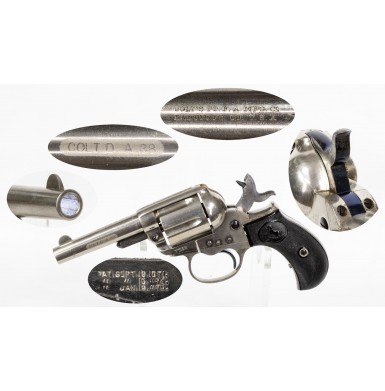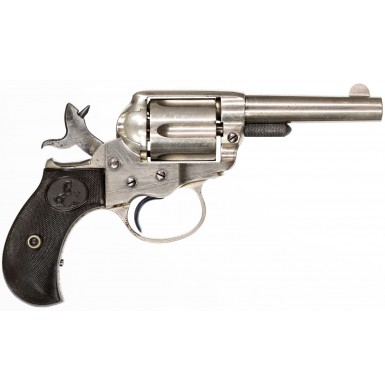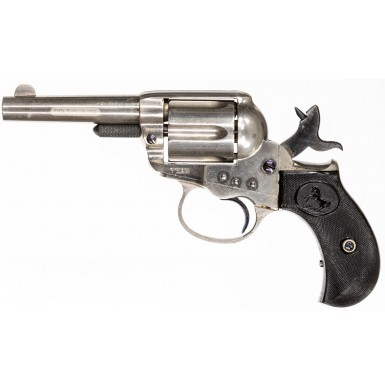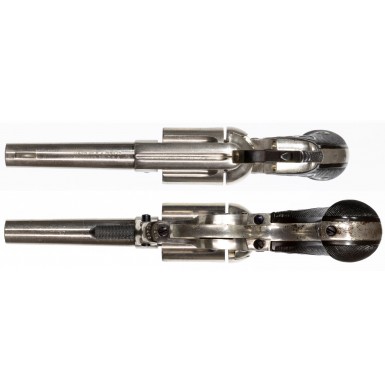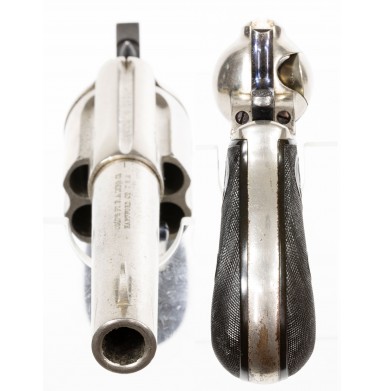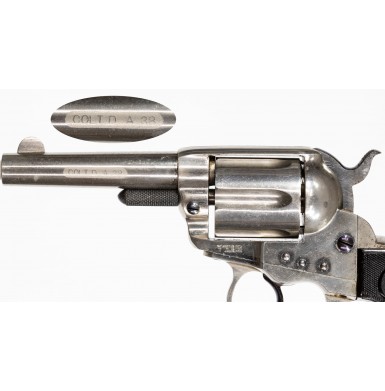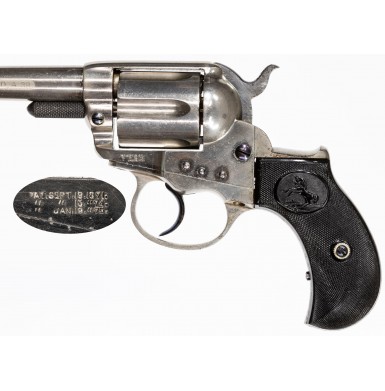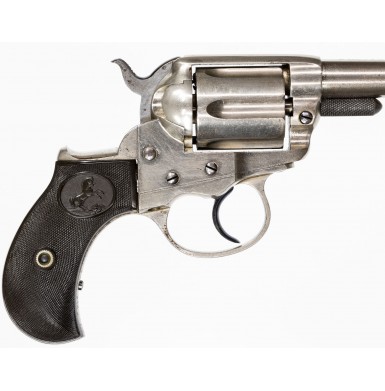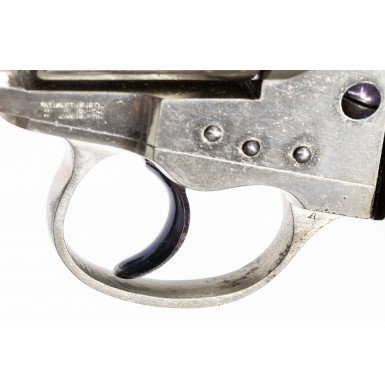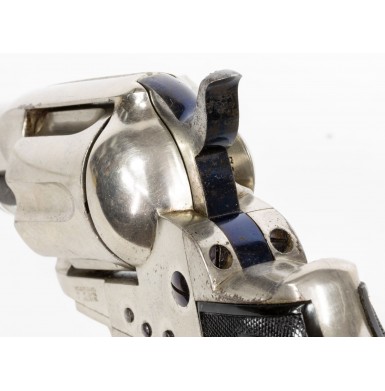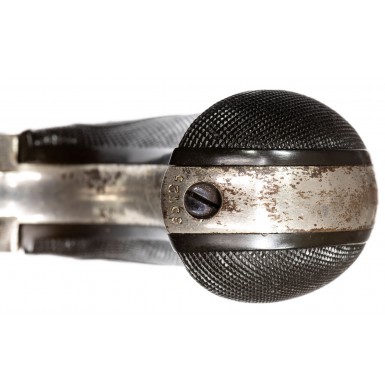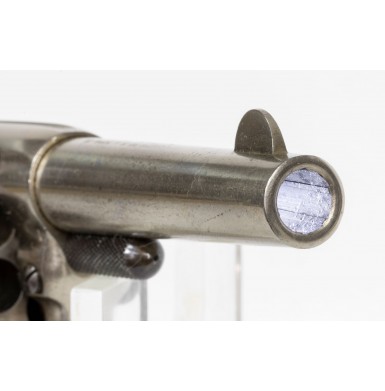Excellent Etched Panel Colt "Lighting" Sheriff's Model Revolver
- Product Code: FHG-3453-SOLD
- Availability: Out Of Stock
-
$2,795.00
In 1877 Colt introduced their first entry into the double action revolver market. While they had a commanding lead over their competition when it came to single action handguns with their “Model P”, better known as the US Model 1873 Single Action Army, they had fallen behind some of the competition in their failure to manufacture a double action revolver. Remington had been in the double action cartridge revolver market for over a decade by 1877 and had manufactured double action percussion revolvers prior to that. Smith & Wesson, which was Colt’s major competition in the handgun market at that time had yet to introduce a double action handgun and would not do so until 1880. No doubt the powers that be at Colt also considered that the popularity of the double action mechanism in Great Britain might help Colt develop additional inroads in that market.
The Model 1877 was not the modern double action, swing out cylinder handgun that comes to mind when one thinks of double action revolvers today. Instead, the 1877 was essentially a scaled down Single Action Army with a fixed six-shot fluted cylinder retained by a conventional arbor pin that was still loaded and unloaded through a gate in the right side of the frame, and which introduced a compact and somewhat elegant “bird’s head” grip that was both comfortable and made the guns easier to conceal in a pocket. The primary differences from the larger Single Action Army were the double action mechanism, the placement of the locking notches for the cylinder on the rear face of the cylinder like the New Line series of handguns and the lower power cartridges the guns were chambered for. The initial production calibers for the revolvers were .38 Colt and .41 Colt, with both cartridges available in a “long” and “short” variant, and with .32 Colt added to the product line in 1888. This last caliber was dropped circa 1900, with only about 200 of the .32 caliber guns being produced during that time frame. The guns are known today by their nicknames which were introduced by one of Colt’s largest distributors, Benjamin Kittredge of Cincinnati, OH. In period advertising, Kittredge referred to the .38 caliber variant as the “Lightning” and the .41 caliber version as the “Thunderer”. The .32 caliber version received the moniker “Rainmaker”. Like most Colt handguns of the period there were two standard finishes, blued barrels and cylinders with color casehardened frames and full nickel finish. In both cases the screws and small parts were typically fire blued and the hammers were polished bright on the sides with the top and spur fire blued as well. Early production guns had checkered two-piece rosewood grips, but by about 1880 checkered hard rubber grips were standard. Like any Colt handgun of the period, special order finishes and grips were available at extra cost, with ivory and mother of pearl being the most popular grip upgrades and finish upgrades being limited only by the buyer’s imagination and budget. Engraving as well as grip carvings were also available upgrades. Like the numerous finish options, a number of barrel lengths were available as well. The standard lengths ran from 1 ½” to as long as 10”, typically in ½” or sometimes 1” increments. Guns with barrels shorter than 4 ½” were produced without an ejector mechanism, although some of the guns with longer barrels were special ordered without ejectors as well. Some of the rarest barrel lengths are 1 ½”, 2” and 6” without the ejector rod and any barrel length of 7” or longer. The guns were typically marked with a two-line barrel address regardless of their length and the left side of the frame was marked with a three-date in three-line patent mark and a Rampant Colt in a circle logo. Caliber markings were applied to the left side of the barrels of most guns from about 1880 onward. For the first few years these markings were acid etched, but by the latter part of the 1880s the markings were being applied with a roll die. Those guns not marked on the barrel were normally marked with the caliber on the left side triggerguard web. The guns were very successful for Colt, and during their 33-year production run from 1877 to 1909 some 166,849 were manufactured. The Model 1877 also provided the springboard for the launch of the larger framed Model 1878 “Frontier” the following year, but the 1878 was not nearly as successful with only about 51,000 being produced during its production run, despite being offered in some of the most popular handgun calibers of the period like .44-40, .38-40 and .45 Colt. Some of the luminaries known to have owned or carried Colt 1877 revolvers include the infamous “Billy the Kid” who was supposedly carrying a Lightning the night he was killed by Pat Garrett, John Wesley Harding who was known to prefer a Thunderer and the artist Frederic Remington who also owned a Thunderer that he purchased in March of 1895.
Offered here is an EXCELLENT condition example of a Colt Model 1877 Lighting “Sheriff’s Model” Revolver. As the name indicates, the revolver is chambered for the .38 Colt cartridge and is one of the shorter barreled, ejectorless guns. The revolver has a 3 1/2'” barrel without and ejector mechanism and the long, checkered cylinder arbor pin that was typical of the ejectorless guns. This allowed the arbor pin to double as an ersatz ejector rod when removed from the frame. These ejectorless guns were also referred to as “Storekeeper” models, as the shorter, ejectorless barrel was easier to carry concealed or in a discrete manner. The gun is serial number 65725 and was produced in 1888. The gun has a full nickel finish with blued screws and small parts and the standard Colt checkered hard rubber grips with the Rampant Colt logo at the frame junction. The gun has the standard markings, including the two-line barrel address which reads
COLT’S PT.F.A. MFG. Co
HARTFORD. CT. U.S.A
and the usual three-date in three-line patent marking on the lower front left of the frame. This marking reads
PAT. SEPT. 19, 1871
“ “ 15, 1874
“ JAN. 19, 1875
and is followed by the Rampant Colt logo in a circle. The left side of the barrel is acid etched in a single line:
COLT D.A. 38
The etched panel remains about 90%+ intact with only the most minor wear and loss due to carry and handling. The matching serial number 65725 is found on the bottom of the bird’s head grip, on the bottom of the triggerguard, on the bottom of the frame and on the rear face of the cylinder which is simply numbered 725. The loading gate has the assembly number 762 which is unrelated to the serial number and is an assembly number only, just as it is on a Single Action Army. These numbers never match the serial number. The grips fit perfectly and are certainly period but are not pencil or scratch numbered on their interior.
The revolver remains in about EXCELLENT overall condition. It retains about 93%+ of the original nickel finish overall. The largest areas of loss are some flaking on the gripstrap and backstrap and some minute areas of freckled loss here and there. There are also some lightly scattered freckles of surface oxidation and discoloration on the gun here and there. They are quite small really only visible under strong light and close scrutiny. The aeras of flaked loss show a moderately oxidized brown patina. The blued screws retain about 85%+ of their bright blue, with some thinning and fading, as does the trigger. The trigger shows some thinning and fading, particularly along the edges where it is contacted and handled. The top of the hammer spur and back of the hammer retain even more bright blue. The long, checkered cylinder arbor pin retains nearly all of the blued finish, but it has thinned, faded, and dulled somewhat and is only about 50% vibrant.
All of the markings on the gun remain clear and crisp. The metal of the gun is entirely smooth with only some minute freckled oxidation as previously mentioned and is free of pitting. The revolver is mechanically excellent and operates as it should, timing, indexing, and locking up as it should. The bore of the revolver is in about VERY FINE condition. It is almost entirely bright with extremely crisp rifling and only some lightly scattered freckling that might be dirt or debris as much as surface oxidation. The bore is for all practical purposes free of any pitting. The two-piece checkered hard rubber grips are in VERY FINE condition as well. They are solid and free of any breaks or repairs and show only a small number of minor handling marks and tiny mars from carry and use.
Overall, this is an extremely attractive Colt Model 1877 Lightning “Sheriff’s Model” Revolver. The gun remains in outstanding condition and retains nearly all of the coveted “etched panel” caliber marking on the barrel. The Colt 1877 revolvers are notorious for mechanical issues and this gun works perfectly and is in solid mechanical condition. This would be a truly fine addition to any advanced collection of Colt revolvers or handguns of the American West and is a gun that you will be truly proud to display.
SOLD
Tags: Excellent, Etched, Panel, Colt, Lighting, Sheriff's, Model, Revolver

